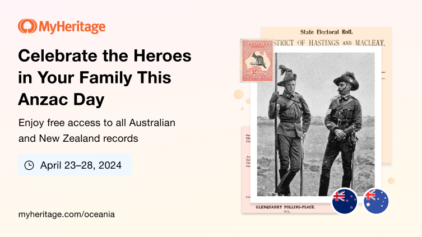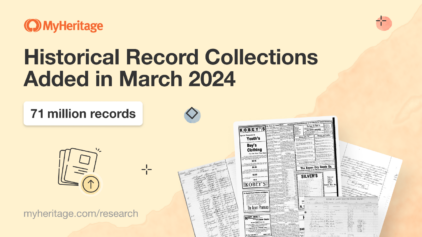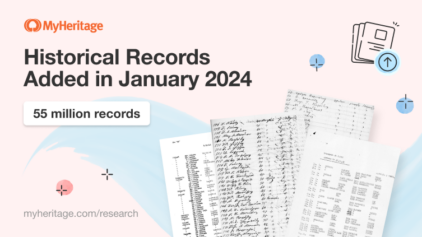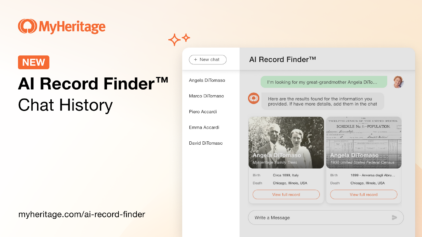MyHeritage Publishes 4.7 Million Brazilian Immigration Records
- By Talya


We are delighted to announce that MyHeritage has published a remarkable collection of 4.7 million immigration records from São Paulo, Brazil. Most of the records cover the period of 1888–1960, with a few hundred going back as early as 1880. They all include an index created by MyHeritage and high-quality scans of the original documents. Most of the scanned documents include passport photos of the immigrants. If you have relatives who immigrated to Brazil during this time, or to South America in general via Brazil, you may make an exciting discovery by locating their photograph and important details about their lives in this collection.
Search Brazil, São Paulo Immigration Cards
Starting in 1880 and in less than a century, a huge wave of immigration brought 5.6 million people across the Atlantic to Brazil. Immigrants from Italy, Portugal, Spain, Germany, and other places came in search of new job opportunities in Brazil’s bustling new factories and agriculture industries.
This collection consists of immigration cards that were issued at Brazilian consulates throughout the world. The cards were processed upon arrival to Brazil, primarily at the Port of Santos in São Paulo. Records include the full name of the individual, date and place of birth, date and place of arrival, reported or declared residence, nationality, and the names of the individual’s parents. Notably, most records also contain a photograph of the individual.
This collection contains not only records of immigrants who were planning to stay permanently in Brazil, but also records of people who were passing through. Other immigration-related documents can also be found in the collection, such as passport applications and arrivals of native Brazilians, though these make up a minority of the records.
Immigration registration was mandatory and the immigrant was to update the federal department, Secretary of Public Security, on any changes in their status and residence, as well as the intention to leave the country through the request of a special visa. The latter can also be found as part of the collection, containing updated information on the person and the places they intended to visit during their trip overseas.
Example
In the Brazil, São Paulo Immigration Cards collection, we find records for Richard Hugh Fisk, known affectionately by Brazilians simply as Mr. Fisk.
Born in Vermont on February 3rd, 1922, Richard struggled with life during the Cold War era. He was in his late 20s when he first set foot on the shores of Santos, following an invitation from his older brother, who was working at the American Consulate. What was supposed to be a quick trip for a breath of fresh air turned into a new reality with a new nationality.
Richard fell in love with Brazil and its people and left behind his life in the U.S. Seeing the huge potential in teaching English as a second language, he became a teacher and later a successful entrepreneur in Brazil, owning one of the biggest language school chains in South America. Richard Fisk was also known as Mr. Pep, a lovely character with heavily-accented Portuguese who taught English in a make-believe school for several years on TV.
The record includes Richard’s name, date and place of birth, arrival date, residence, and the names of his father and mother. It also links to all the documents in the collection that match Richard’s name and details, enabling you to flip from one to the next and better understand his travels in and out of Brazil. It captures a snapshot of Fisk during each of the journeys in and out of Brazil by including an updated passport photo.
An impressive set of 14 records documenting Richard Hugh Fisk is available in the São Paulo Immigration Cards collection, including his original immigration card from 1950 and subsequent visa requests for when he needed to travel out of the country. Each one has a passport photo, which allows us to see how his appearance changed over the years. We’re also able to see the short season in his life when his status changed from single to married and then back to single.
Thanks to the high definition of all images in the collection, we were able to take advantage of MyHeritage’s photo tools to colorize and enhance this image of Richard from his first arrival in 1951.
![Passport photo on Richard Fisk's immigration card, 1950. Repaired, enhanced, and colorized on MyHeritage [Credit: MyHeritage Brazil, São Paulo Immigration Cards]](https://blog.myheritage.com/wp-content/uploads/image2-14.jpg)
Passport photo on Richard Fisk’s immigration card, 1950. Repaired, enhanced, and colorized on MyHeritage [Credit: MyHeritage Brazil, São Paulo Immigration Cards]
Summary
The Brazil, São Paulo Immigration Cards collection is an invaluable asset for anyone looking for their immigrant ancestors just as they embarked on their new life in Brazil, or South America in general. These records join our growing collection of Brazilian records on MyHeritage, including the exclusive Pernambuco births, marriages, and death records we recently added, also digitized by MyHeritage. We hope the collection will offer new avenues to explore the lives of your ancestors and enrich your family tree.
Searching these collections is free. To view these records or to save records to your family tree, you’ll need a Data or Complete subscription.
If you have a family tree on MyHeritage, our Record Matching technology will notify you automatically if records from this collection match your relatives. You’ll then be able to review the record and decide if you’d like to add the new information to your tree.
Enjoy the collection!










